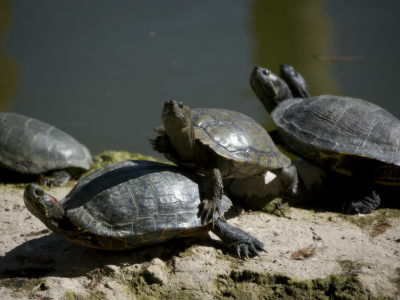Is it true that turtles can breathe not only lungs but also 'butt breaths'?

Among turtles, there are species that mainly live in the water, and in winter, they can be seen standing still in the water. There is a theory that such turtles can spend a long time underwater because they can breathe not only lungs but also ``buttocks breathing'', but whether turtles can actually breathe buttocks is summarized by the scientific media Live Science.
Can turtles really breathe through their butts?
``Technically speaking, turtles don't breathe through their butts, because they don't exactly have ``butts'','' said Harry Baker, a writer at Live Science. However, turtles have an organ called the cloaca , which also serves as an anus, urinary opening, and reproductive opening. It seems that you can not say 'breathing'.
According to Craig Franklin, a biophysiologist at the University of Queensland, Australia, cloaca-breathing turtles pump water from the cloaca into two pouch-like organs called mucosal sacs. . And the oxygen contained in the water pumped up by the mucosal sac diffuses into the blood through small protrusions lined up on the wall surface, which is the mechanism of turtle's 'cloacal respiration'.
However, cloacal respiration is very inefficient compared to normal pulmonary respiration, and many turtles live by pulmonary respiration. Therefore, only a few freshwater species that need to adapt to environments where it is difficult to breathe air, such as fast-flowing rivers and frozen ponds, use cloaca respiration in earnest.

The major turtles that utilize cloaca breathing live in rivers, and it is known that there are more than 10 species of river-dwelling turtles that are capable of cloaca breathing in the world. About half of them inhabit Australia, and there are
Hayase turtles, which are distributed in Australia, inhabit the bottom of fast-flowing rivers (rapids) , and can obtain 100% oxygen by cloacal respiration. Because it is completely aquatic, it rarely lands on land other than spawning, and it is rare even to perform lung breathing.
However, cloacal respiration alone is not sufficient for all species except the Hayase tortoise to meet their oxygen needs, which only extends the amount of time they can remain underwater. “Instead of, say, holding your breath and staying underwater for 15 minutes, you can stay underwater for hours,” says Franklin.
Cloacal respiration is useful for species like the Hayase tortoise, which allows them to breathe underwater, as they risk being swept away if they rise to the surface to breathe in fast currents. Also, staying still on the bottom reduces the chances of being spotted by predators. This advantage is especially important for baby turtles, which are more likely to be targeted by birds and large fish, Franklin said. . Juvenile turtles generally have better cloacal respiration than adults.
At first glance, cloaca breathing seems to have only advantages, but it also has the disadvantage of being much less energy efficient than pulmonary breathing. ``When we inhale, the gas is light and moves freely in and out of the lungs, so little energy is required, but imagine trying to inhale a viscous liquid,'' Franklin said. I'm here. In addition, the amount of oxygen contained in water is only about 1/200 compared to the same amount of air, and there is also energy consumption due to osmotic pressure regulation, so it seems that cloacal respiration is considerably less energy efficient. .

In addition, six to seven species of freshwater turtles distributed throughout North America have the ecology of ``hibernating on the frozen bottom of the water in winter'' and are capable of a limited type of cloacal respiration. These species hibernate for several months on the frozen bottom of the water, so they can stay under the ice for more than 100 days without even touching the air.
However, the cloacal respiration performed by these species differs from the cloacal respiration performed by species such as the Hayase tortoise in that it passively transfers oxygen from the water to the surface of the mucosal sac, rather than actively pumping water into the mucosal sac. It is done in a way that spreads This process is similar to cutaneous respiration, and in that sense amphibians, reptiles and, to a limited extent, some mammals, including humans, also have this ability.
'Hibernating turtles have a significantly reduced metabolic rate and need less oxygen to survive by passive cloacal respiration,' said Jackie Ritzgas, a bioecologist at Laurentian University in Canada. I can,' he said.
Related Posts:







